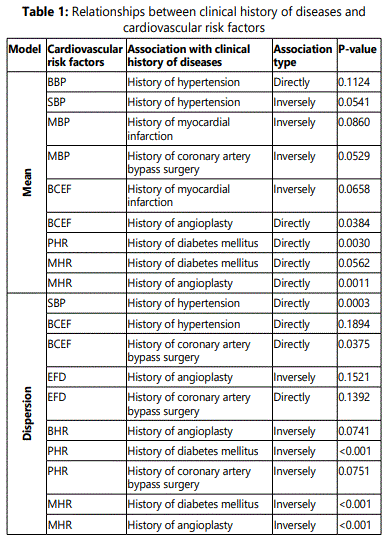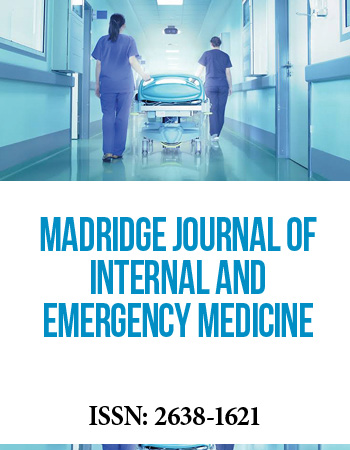Editorial Article
The Impact of the Clinical History of Diseases on Cardiovascular Risk Factors
1Department of History, University of Burdwan, Burdwan, West Bengal, India
2Department of Statistics, University of Burdwan, Burdwan, West Bengal, India
*Corresponding author: Rabindra Nath Das, Professor, Department of Statistics, University of Burdwan, Burdwan, West Bengal, India, E-mail: rabin.bwn@gmail.com
Received: October 23, 2021 Accepted: November 09, 2021 Published: November 15, 2021
Citation: Das M, Das RN. The Impact of the Clinical History of Diseases on Cardiovascular Risk Factors. Madridge J Intern Emerg Med. 2021; 5(1): 159-161. doi: 10.18689/mjiem-1000136
Copyright: © 2021 The Author(s). This work is licensed under a Creative Commons Attribution 4.0 International License, which permits unrestricted use, distribution, and reproduction in any medium, provided the original work is properly cited.
Abstract
It is well-known that there are several effects of the clinical history of diseases on cardiovascular risk factors [1-3]. The current editorial report focuses on the impact of the clinical history of diseases on cardiovascular risk factors. The considered clinical history of diseases are history of diabetes mellitus, history of hypertension, history of myocardial infarction, history of coronary artery bypass surgery and history of angioplasty. On the other hand, the considered cardiovascular risk factors are systolic blood pressure (SBP), basal blood pressure (BBP), maximum blood pressure (MBP), peak heart rate (PHR), basal heart rate (BHR), maximum heart rate (MHR), baseline cardiac ejection fraction (BCEF), ejection fraction on dobutamine dose (EFD). The associations between the above clinical history of diseases and cardiovascular risk factors are focused in the current report. These associations are little studied in the previous articles [1-3]. The current report searches the associations between the clinical history of diseases and cardiovascular risk factors based on a real data set of 558 subjects who underwent dobutamine stress echocardiography (DSE) [4]. These associations are derived based on the model of each cardiovascular risk factor on the remaining covariates. It is derived herein that each cardiovascular risk factorʼs mean, or variance, or both is statistically significant, or partially associated with one, or more clinical history of diseases. Therefore, clinical history of diseases should be considered for heart disease treatments.
Keywords: Cardiovascular disease; Hypertension; Surgery.
For ready reference, the considered DSE data set factors/ variables are reproduced as follows: Age, Gender (male=0, female=1), BBP, SBP, BHR, PHR, Product of BBP & BHR, Product of PHR & SBP, MHR, Dobutamine dose (DOSE), MBP, Product of maximum DOSE & MBP, Percent maximum predicted heart rate, Dobutamine dose at maximum double product, BCEF, EFD, chest pain (yes (y)=0, no (n)=1), positive stress on echocardiogram (y=0, n=1), recent angioplasty (y=0, n=1), resting wall motion abnormality on echocardiogram (y=0, n=1), recent bypass surgery (y=0, n=1), new myocardial infarction (y=0, n=1), death (y=0, n=1), history of hypertension (y=0, n=1), history of diabetes mellitus (y=0, n=1), history of myocardial infarction (y=0, n=1), history of coronary artery bypass surgery (y=0, n=1), history of angioplasty (y=0, n=1), history of smoking (y=0, n=1), baseline electrocardiogram diagnosis (y=0, n=1). Note that there are 8 cardiovascular disease risk factors and 5 clinical history of diseases in the DSE data set.
The association between clinical history of diseases and cardiovascular risk factors can be obtained by modeling each cardiovascular risk factor on all the remaining factors/variables. Note that each cardiovascular risk factor is positive, heteroscedastic, continuous and non-normal, so it can be modeled suitably by joint generalized linear models (JGLMs), which are clearly illustrated in the book by [5,6]. Based on each cardiovascular risk factor modeling by JGLMs fitting, the following relationships between clinical history of diseases and cardiovascular risk factors have been derived.
The analysis of BBP shows that mean BBP is directly associated with history of hypertension (P=0.1124), indicating that DSE patients with no history of hypertension have higher mean BBP [1].
The SBP analysis reveals that mean SBP is inversely associated with history of hypertension (P=0.0541), indicating that it is higher for the DSE patients with history of hypertension. Also variance of SBP is directly associated with history of hypertension (P=0.0003), concluding that SBP variance is highly scattered for the DSE patients with no history of hypertension [1].
The MBP analysis shows that mean MBP is inversely associated with history of myocardial infarction (P=0.0860), or history of coronary artery bypass surgery (P=0.0529), interpreting that DSE patients with history of myocardial infarction, or history of coronary artery bypass surgery have higher mean MBP [1].
The BCEF analysis reveals that mean BCEF is inversely associated with history of myocardial infarction (P=0.0658), implying that BCEF is higher for DSE patients with history of myocardial infarction. Also, mean BCEF is directly associated with history of angioplasty (P=0.0384), concluding that mean BCEF is higher for the DSE patients with no history of angioplasty. Variance of BCEF is directly associated with history of hypertension (P=0.1894), or history of coronary artery bypass surgery (P=0.0375), implying that BCEF values are largely scattered for the DSE patients with no history of hypertension, or history of coronary artery bypass surgery [3].
The EFD analysis presents that EFD variance is inversely associated with history of angioplasty (P=0.1521), indicating that EFD values are highly scattered for the DSE patients with history of angioplasty. Also EFD variance is directly associated with history of coronary artery bypass surgery (P=0.1392), concluding that EFD values are highly scattered for the DSE patients with no history of coronary artery bypass surgery [3].
The BHR analysis reveals that BHR variance is inversely associated with history of angioplasty (P=0.0741), implying that BHR values are highly scattered for the DSE patients with history of angioplasty [2].
The PHR analysis shows that mean PHR is directly associated with history of diabetes mellitus (P=0.0030), concluding that it is higher for the DSE patients with no history of diabetes mellitus. Also PHR variance is inversely associated with history of diabetes mellitus (p<0.001), and history of coronary artery bypass surgery (P=0.0751), implying that PHR values are highly scattered for the DSE patients with history of diabetes mellitus, or history of coronary artery bypass surgery [2].
The MHR analysis shows that mean MHR is directly associated with history of diabetes mellitus (P=0.0562), or history of angioplasty (P=0.0011), concluding that it is higher for the DSE patients with no history of diabetes mellitus or history of angioplasty. Also MHR variance is inversely associated with history of diabetes mellitus (p<0.001), or history of angioplasty (P<0.001), interpreting that MHR values are highly scattered for the DSE patients with history of diabetes mellitus, or history of angioplasty [2].
These above associations between clinical history of diseases and cardiovascular risk factors for DSE patients are summarized in Table 1.

The relationships between clinical history of diseases and cardiovascular risk factors have been derived by adopting gamma JGLMs of each cardiovascular risk factor. The above outcomes reveal that cardiovascular risk factors are highly associated with clinical history of diseases. These outcomes support that clinical history of diseases are definitely a risk factor of heart disease. These outcomes will be helpful for medical practitioners to provide better treatment for heart patients.
Conflict of interest: The authors confirm that this article content has no conflict of interest.
Acknowledgement: The authors are very much grateful to the reviewers for their fruitful comments to improve the paper.
References
- Das RN. Hypertension risk factors who underwent Dobutamine stress echocardiography. Interventional Cardiology. 2016; 8(5); 595-605.
- Das RN, Lee Y, Mukhopadhyay BB. The basal, peak and maximum heart rate determinants of the cardiac patients who underwent dobutamine stress echocardiography. Mathews Journal of Cardiology. 2017; 2(2): 013.
- Das RN. Determinants of Cardiac Ejection Fraction for the Patients with Dobutamine Stress Echocardiography. Epidemiology. 2017; 7(3): 307.
- Krivokapich J, Child JS, Walter DO, Garfinkel A. Prognostic value of dobutamine stress echocardiography in predicting cardiac events in patients with known or suspected coronary artery disease. J Am Col Cardiol. 1999; 33(3): 708-716. doi: 10.1016/s0735-1097(98)00632-9
- Das RN, Lee Y. Log-normal versus gamma models for analyzing data from quality-improvement experiments. Quality Engineering. 2009, 21(1): 79-87. doi: 10.1080/08982110802317372


